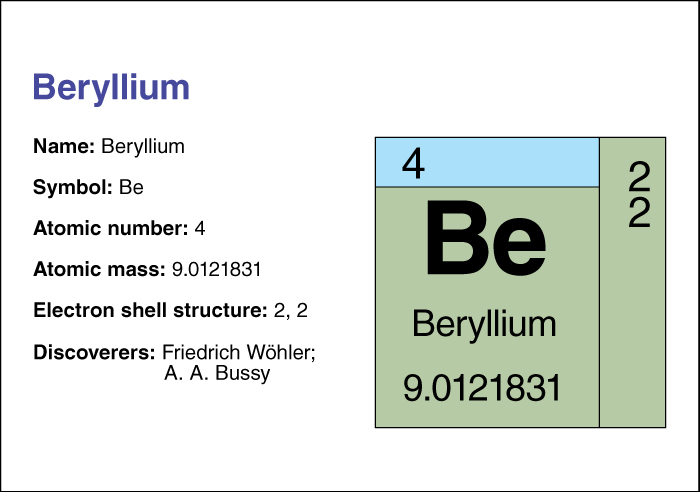Beryllium << buh RIHL ee uhm >> is a rare, light-gray metallic element. Beryllium never occurs in nature as a pure metal. But it is found in bertrandite, beryl, chrysoberyl, phenacite, and other minerals. Beryl and bertrandite are the most important sources of beryllium. The German chemist Friedrich Wohler and the French chemist A. A. Bussy, working independently, isolated the first samples of pure beryllium in 1828.

Beryllium’s atomic number (number of protons in its nucleus) is 4. Its relative atomic mass is 9.012182. An element’s relative atomic mass equals its mass (amount of matter) divided by 1/12 of the mass of carbon 12, the most abundant form of carbon. Beryllium’s chemical symbol is Be. Beryllium is a brittle, lightweight metal with one of the highest melting points of all light metals. It melts at temperatures from 1273 to 1283 °C and boils at 2970 °C. At 20 °C, it has a density of 1.848 grams per cubic centimeter (see Density ). Beryllium belongs to the group of elements called alkaline earth metals . For information on the position of beryllium on the periodic table, see the article Periodic table .
X rays pass easily through pure beryllium. For this reason, the metal is used to make small windows in X-ray tubes. Beryllium’s light weight and its capacity for absorbing and conducting heat make it useful for specialized parts in satellites, missiles, and rockets. An alloy of beryllium and copper is used to make electrical parts, such as electrically conducting springs. Beryllium oxide is a good heat conductor but a poor electrical conductor. It is used as a heat-conducting electrical insulator in electronic devices and lasers.
If beryllium dust is inhaled, it can cause berylliosis, a chronic lung disease that is sometimes fatal. Some scientists believe beryllium may also produce lung cancer. The United States government has set safety standards to protect workers from excessive exposure to the metal and its compounds.
